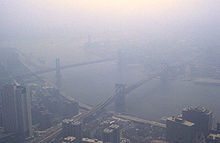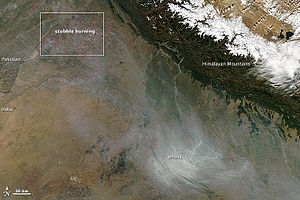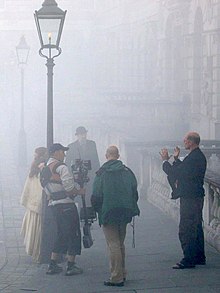From Wikipedia, the free encyclopedia
Cancer research is basic research into cancer in order to identify causes and develop strategies for prevention, diagnosis, treatments and cure.
Cancer research ranges from epidemiology, molecular bioscience to the performance of clinical trials to evaluate and compare applications of the various cancer treatment. These applications include surgery, radiation therapy, chemotherapy, hormone therapy, Immunotherapy and combined treatment modalities such as chemo-radiotherapy. Starting in the mid-1990s, the emphasis in clinical cancer research shifted towards therapies derived from biotechnology research, such as cancer immunotherapy and gene therapy.
Areas of research
Cause
Early research on the cause of cancer was summarized by Haddow in 1958.[1] The first chemical carcinogen was identified in 1928-29 as 1:2-5:6-dibenzanthracene, and the carcinogeneic substance in pitch was identified as 3:4-benzopyrene in 1933. Haddow concluded that “there can be little doubt of the importance of their [chemical] combination with the genetical material” as the source of the chemical mechanism of action of carcinogens. Brookes and Lawley, in 1964, summarized ongoing research into the causes of cancer.[2] They referred to the competing hypotheses that carcinogens reacted mainly with proteins versus mainly with DNA. The direct research of Brookes and Lawley, testing carcinogenic hydrocarbons, indicated that they react with DNA. McCann et al.[3] in 1975 and McCann and Ames, in 1976,[4] tested 175 known carcinogens for interaction with DNA sufficient to cause mutations in their new Salmonella/microsome test. This test uses bacteria as sensitive indicators of DNA damage.They found that 90% of known carcinogens caused mutations in their test. They indicated that the carcinogens that did not cause mutations in their assay were likely due to the need for the carcinogens to be activated by enzymes not available in their system.
By 1981, Doll and Peto conducted an epidemiological study in which they compared cancer rates for 37 specific cancers in the United States to rates for these cancers in populations in which the incidence of these cancers is low.[5] The populations compared with US populations included Norwegians, Nigerians, Japanese, British, and Israeli Jews. Their conclusion was that 75 - 80% of the cases of cancer in the United States were likely avoidable. The avoidable sources of cancer included tobacco, alcohol, diet (especially meat and fat), food additives, occupational exposures (including aromatic amines, benzene, heavy metals, vinyl chloride), pollution, industrial products, medicines and medical procedures, UV light from the sun, exposure to medical x-rays, and infection. Many of these sources of cancer are DNA damaging agents.
More recent research, indicating both the role of DNA damage in causing cancer and other factors including reduced expression of DNA repair genes by epigenetic alterations (allowing DNA damages to accumulate) are summarized in Carcinogenesis and in an article by Bernstein et al. in 2013.[6]
Research into the cause of cancer involves many different disciplines including genetics, diet, environmental factors (i.e. chemical carcinogens). In regard to investigation of causes and potential targets for therapy, the route used starts with data obtained from clinical observations, enters basic research, and, once convincing and independently confirmed results are obtained, proceeds with clinical research, involving appropriately designed trials on consenting human subjects, with the aim to test safety and efficiency of the therapeutic intervention method. An important part of basic research is characterization of the potential mechanisms of carcinogenesis, in regard to the types of genetic and epigenetic changes that are associated with cancer development. The mouse is often used as a mammalian model for manipulation of the function of genes that play a role in tumor formation, while basic aspects of tumor initiation, such as mutagenesis, are assayed on cultures of bacteria and mammalian cells.
Important cell types involved in cancer growth
There are several different cell types that are critical to tumor growth. In particular Endothelial Progenitor Cells are a very important cell population in tumor blood vessel growth. This finding was demonstrated in the high impact factor journals of Science (2008) and Genes and Development (2007)which also showed that Endothelial Progenitor Cells are critical for metastasis and the angiogenesis.[7][8] This importance of endothelial progenitor cells in tumour growth and angiogenesis has been confirmed by a recent publication in Cancer Research (August 2010). This seminal paper has demonstrated that endothelial progenitor cells can be marked using the Inhibitor of DNA Binding 1 (ID1). This novel finding meant that investigators were able to track endothelial progenitor cells from the bone marrow to the blood to the tumour-stroma and even incorporated in tumour vasculature. This finding of endothelial progenitor cells incorporated in tumour vasculature proves the importance of this cell type in blood vessel development in a tumour setting. Furthermore, ablation of the endothelial progenitor cells in the bone marrow lead to a significant decrease in tumour growth and vasculature development. Therefore endothelial progenitor cells are very important in tumour biology and present novel therapeutic targets.[9]In vitro research using cell lines
In vitro assays allow scientists to conduct studies under reasonable conditions in the lab. In order to study the communication between a tumor cell and a host cell in vitro assays have been created. The use of fragmented chicken heart cells as a host case for nutrients[10] Thus allowing the HeLa cells to, in a sense win, and over take the PHF. In the case of the L tumor cells, they were not able to invade the PHF. Though HeLa cells were able to accomplish invasion after several hours the L cells are structurally different rendering them inadequate. The L cells have much more intercellular free space and do not surround the host cell as tightly as Hela cells. It was concluded that with a tight gap junction nutrients cannot enter the cell allowing the cancer cells to invade. With this information about the gap junction process between host cell and the tumor cell, further studies were conducted in cancer gene therapy with the use of Hela cells and the herpes virus.[11]
Oncogenomics/Genes involved in cancer
The goal of oncogenomics is to identify new oncogenes or tumor suppressor genes that may provide new insights into cancer diagnosis, predicting clinical outcome of cancers, and new targets for cancer therapies. As the Cancer Genome Project stated in a 2004 review article, "a central aim of cancer research has been to identify the mutated genes that are causally implicated in oncogenesis (cancer genes)."[12] The Cancer Genome Atlas project is a related effort investigating the genomic changes associated with cancer, while the COSMIC cancer database documents acquired genetic mutations from hundreds of thousands of human cancer samples.[13]These large scale projects, involving about 350 different types of tumour, have identified ~130,000 mutations in ~3000 genes that have been mutated in the tumours. The majority occurred in 319 genes of which 286 were tumour suppressor genes and 33 oncogenes.
Several hereditary factors can increase the chance of cancer-causing mutations, including the activation of oncogenes or the inhibition of tumor suppressor genes. The functions of various onco- and tumor suppressor genes can be disrupted at different stages of tumor progression. Mutations in such genes can be used to classify the malignancy of a tumor.
In later stages, tumors can develop a resistance to cancer treatment. The identification of oncogenes and tumor suppressor genes is important to understand tumor progression and treatment success. The role of a given gene in cancer progression may vary tremendously, depending on the stage and type of cancer involved.[14]
Genes and protein products that have been identified by at least two independent publications as being involved in cancer are:[12]
ABI1, ABL2, ACSL6, AF1Q, AF5Q31 (also known as MCEF), AKT1, ARNT, ASPSCR1, ATF1, ATIC, BCL10, BFHD, BIRC3, BMPR1A, BTG1, CBFA2T1, CBFA2T3, CBFB, CCND1, CDC2, CDK4, CHIC2, CHN1, COPEB, COX6C, CTNNB1, CYLD, DDB2, DDIT3, DEK, Eif4a, EIF4A2, EPS15, ERCC2, ERCC3, ERCC5, ERG, ETV4, ETV6, EWSR1, EXT1, EXT2, FANCC, FANCG, FGFR1OP, FGFR3, FH, FIP1L1, FUS, GAS7, GATA1, GMPS, GOLGA5, GPC (gene), GPHN, HIST1H4I, HRAS, HSPCA, IL21R, IIRF4, KRAS2, LASP1, LCP1, LHFP, LMO2, LYL1, MADH4, MEIS1, MLF1, MLH1, MLLT3, MLLT6, MNAT1, MSF, MSH2, MSN, MUTYH, MYC, NCOA4, NF2, NPM1, NRAS, PAX8, PCBD, PDGFB, PHOX2B, PIM1, PLK2, PNUTL1, POU2F1, PPARG, PRCC, PRKACB, PRKAR1A, PTEN, PTPN11, RABEP1, RAD51L1, RAP1GDS1, RARA, RB1, RET, RHOH, RPL22, SBDS, SDHB, SEPTIN6, SET, SH3GL1, SS18L1, SSX1, SSX2, SSX4, STAT3, TAF15, TCF12, TCL1A, TFE3, TFEB, TFG, TFPT, TFRC, TNFRSF6, TP53, TPM3, TPM4, TRIP11, VHL, WAS, WT1, ZNF198, ZNF278, ZNF384, ZNFN1A1
Treatment
Current topics of cancer treatment research include:- Anti-cancer vaccine — based on exposing some cancer cells extracted from a tumour to UV rays for 24 hrs then injecting them back into the organism, this approach has already been successful on rats.
- Chemotherapy
- Gene therapy[15][16]
- Photodynamic therapy
- Radiation therapy
- Reoviridae (Reolysin drug therapy)
- Targeted therapy
Vaccines
- Hepatitis B vaccine: hepatitis B virus which leads to liver cancer.
- HPV vaccine: human papillovirus HPV-16, HPV-18 for cervical cancer, genital warts, anal, vulvar, vaginal, penile, and HPV oral cancers.
- Canine melanoma vaccine[17]
- Oncophage[18]
- Sipuleucel-T (Provenge) is a prostate cancer vaccine
Flaws and vulnerabilities
Newsweek magazine published an article criticising the use of lab rats on cancer research because even though researchers frequently manage to cure lab mice transplanted with human tumors, few of those achievements are relevant to humanity.[19] Oncologist Paul Bunn, from the International Association for the Study of Lung Cancer[20] said: "We put a human tumor under the mouse's skin, and that microenvironment doesn't reflect a person's—the blood vessels, inflammatory cells or cells of the immune system".[19] Fran Visco founder of the National Breast Cancer Coalition completed: "We cure cancer in animals all the time, but not in people."[19]Most funding for cancer research comes from taxpayers and charities, rather than from profit-making businesses. In the US, less than 30% of all cancer research is funded by commercial researchers such as pharmaceutical companies.[21] Per capita, public spending on cancer research by taxpayers and charities in the US was five times as much in 2002-03 as public spending by taxpayers and charities in the 15 countries then full members of the European Union.[21] As a percentage of GDP, the non-commercial funding of cancer research in the US was four times the amount dedicated to cancer research in Europe.[21] Half of Europe's non-commercial cancer research is funded by charitable organizations.[21]
Cancer research processes have been criticised in many respects. These include, especially in the US, hypercompetition for the financial resources and positions required to conduct science, which seems to suppress the creativity, cooperation, risk-taking, and original thinking required to make fundamental discoveries, unduly favoring low-risk research into small incremental advancements over innovative research that might discover radically new and dramatically improved therapy. Other consequences of today's highly pressured competition for research resources appear to be a substantial number of research publications whose results cannot be replicated, and perverse incentives in research funding that encourage grantee institutions to grow without making sufficient investments in their own faculty and facilities.[22][23][24][25]
Distributed computing
One can share computer time for distributed cancer research projects like Help Conquer Cancer.[26] World Community Grid also had a project called Help Defeat Cancer. Other related projects include the Folding@home and Rosetta@home projects, which focus on groundbreaking protein folding and protein structure prediction research.Organizations
- Cancer organizations
- American Association for Cancer Research
- American Brain Tumor Association
- American Cancer Society
- American Society of Clinical Oncology
- Australian Cancer Research Foundation
- Brain Tumor Foundation of Canada
- Brain Tumor Funders' Collaborative
- CACA[disambiguation needed]
- Canadian Cancer Society
- Cancer Research
- Cancer Research Foundation
- Cancer Research UK
- Childhood Cancer Research Group
- Damon Runyon Cancer Research Foundation
- Dana-Farber/Harvard Cancer Center
- E-Foundation for Cancer Research
- Fred Hutchinson Cancer Research Center
- Friends of Cancer Research
- Gateway for Cancer Research
- German Cancer Research Center
- Institute of Cancer Research
- International Agency for Research on Cancer
- International Cancer Genome Consortium
- Israel Cancer Research Fund
- James S. McDonnell Foundation
- Joe Andruzzi Foundation
- Lance Armstrong Foundation
- Leukaemia & Lymphoma Research
- Ludwig Institute for Cancer Research
- Memorial Sloan-Kettering Cancer Center
- National Brain Tumor Society
- National Cancer Institute
- National Foundation for Cancer Research
- National Institute of Health
- NCI-designated Cancer Center
- Northern California Cancer Center
- Quality Assurance Review Center
- Relay For Life
- Save A Brain Foundation
- SENS Research Foundation
- Terry Fox Foundation
- TGen
- Tower Cancer Research Foundation
- United Devices Cancer Research Project
- University of Texas MD Anderson Cancer Center
- Walker Cancer Research Institute

















